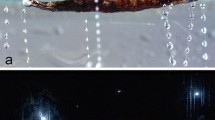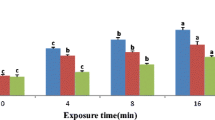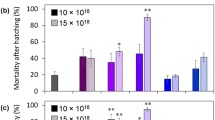Abstract
Ultraviolet irradiation of mulberry leaves caused a reduced feeding response inBombyx mori larvae (ca. 22% reduction in consumption as compared with control). Sucrose content of the foliage decreased after exposure to UV irradiation (0.5 mW/cm2 for 1 hr. Electrophysiological responses of the sensilla styloconica-I to sucrose concentration (ca. 0–80 mg/g) showed a reduced response to UV-irradiated foliage when compared with the control. From feeding, gustatory, and electrophysiological responses, as well as the measurement of sucrose contents of the leaves, we concluded that the reduced feeding response to UV-irradiated leaves is due to the reduced sucrose content of the mulberry leaves, thus reducing pleogostimulatory levels.
Similar content being viewed by others
References
Berenbaum, M. 1978. Toxicity of a furanocoumarin to armyworms: A case of biosynthetic escape from insect herbivores.Science 201:532–534.
Hirao, T., andArai, N. 1991. On the role of gustatory recognition in host-plant selection by the silkworm,Bombyx mori L.Jpn. J. Appl. Entomol. Zool. 35:197–206.
Ishikawa, S. 1963. Responses of maxillary chemoreceptors in the larva of the silkworm,Bombyx mori, to stimulation by carbohydrates.J. Cell. Comp. Physiol. 61:99–107.
Ishikawa, S. 1966. Electrical response and function of a bitter substance receptor associated with the maxillary sensilla of the larvae of the silkworm,Bombyx mori L.J. Cell. Comp. Physiol. 67:1–11.
Naito, K., andHamamura, Y. 1961. On the isolation of myoinositol from mulberry leaves.J. Agric. Chem. Soc. Jpn. 35:1106–1107.
Takeuchi, Y., Akizuki, M., Shimizu, H., Kondo, N., andSugahara, K. 1989. Effect of UV-B (290–320 nm) irradiation on growth and metabolism of cucumber cotyledons.Physiol. Planta 76:425–430.
Yazawa, M., andYamashita, T. 1974. Metabolic conversion of photosynthetic14CO2 fixation product and sucrose formation by the use of mulberry leaf segments.J. Serie. Sci. Jpn. 43:304–310.
Yazawa, M., Hirao, T., Arai, N., andYagi, S. 1991a. Feeding and gustatory responses in the “polyphagous silkworm,”Bombyx mon L.J. Seric. Sci. Jpn. 60:363–371.
Yazawa, M.,Isogai, A., andSuzuki, N. 1991b. 61st Annual meeting of the Japanese Society of Sericultural Science, April, Tokyo.
Zangerl, A.R., andBerenbaum, M.R. 1987. Furanocoumarins in the wild parsnip: Effects of photosynthetically active radiation, ultraviolet, light, and nutrients.Ecology 68:516–520.
Author information
Authors and Affiliations
Rights and permissions
About this article
Cite this article
Yazawa, M., Shimizu, T. & Hirao, T. Feeding response of the silkworm,Bombyx mori, to UV irradiation of mulberry leaves. J Chem Ecol 18, 561–569 (1992). https://doi.org/10.1007/BF00987819
Received:
Accepted:
Issue Date:
DOI: https://doi.org/10.1007/BF00987819




